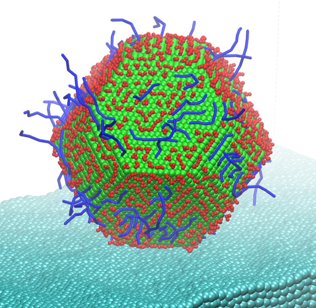Fischer–Tropsch synthesis is a set of catalytic processes that can be used to produce fuels and chemicals from synthesis gas (mixture of CO and H2), which can be derived from natural gas, coal, or biomass. Biomass to Liquid via Fischer–Tropsch synthesis (FTS) is gaining increasing interests from industry because of its ability to produce carbon neutral and environmentally friendly clean fuels. In this webinar we have the honor to host Prof. Ioannis Economou from Texas A&M University at Qatar. He will outline how transport processes in FTS related systems are expected to open new pathways in the investigation of the effect of nanoparticles on catalyst support interfaces in the presence of FTS relevant mixtures.
The examples presented will demonstrate how to design catalytic systems using molecular simulation strategies applied on a ‘digital twin’ of the systems of interest. In particular::
- Impact of catalytic nanoparticles on component diffusion
- Effect of polar molecules in reaction mixture
- Impact of confinement on phase stability

Figure 1: Cobalt nanoparticle on GO surface
Clean, high quality, low emission fuels with Fischer-Tropsch polymerization: A mesoscale study of transport processes in confined systems
Prof. Ioannis G. Economou
Texas A&M University at Qatar, Chemical Engineering Program, Education City, PO Box 23874, Doha, Qatar
Abstract: The Fischer-Tropsch (FT) route is a polymerization reaction used extensively in the Gas-to-Liquids (GTL) process to transform synthesis gas (H2 and CO)1 into clean, high quality low emission transportation fuels. The main FT reaction products, namely water, wax and small amounts of oxygenates (e.g. alcohols < 10 wt %), form a mixture through which the dissolved reactants diffuse, reach the catalytic nanoparticles and react. The transport properties of these mixtures, particularly inside catalyst pores, is a topic of significant interest for the petrochemical industry. Key factors in ensuring FT reactor’s activity and stability is the selection of the catalyst (e.g. Co) and the support material. In order to gain a better understanding of the phase behaviour of confined wax – water – alcohol mixtures in hydrophilic or hydrophobic environments at reaction conditions, our efforts concentrated on the the n-C28 – H2O mixture at 473.15 K inside pristine graphene (G) and graphene oxide (GO) pores by means of Coarse Grained Molecular Dynamics (CGMD) simulations with MARTINI. Dodecan-1-ol was used to study the effect of long-chain alcohols on the wax – water mixture inside mesopores. Our simulations show that CG approaches capture the mixture’s phase separation, the component’s diffusivity as a function of the distance from the pore center and that dodecan-1-ol’s preference towards the wax being mostly located at the n-C28 – H2O interface. CGMD simulations with DFT derived parameters for Co, show that the Co NP does not affect phase separation of the mixture inside the pores. However, extensive coverage by water on the Co NP is observed. Given the experimental difficulties in probing the relevant mechanisms at this scale, our results showcase that CGMD using the MARTINI force field can be employed to study FTS related processes at this level2,3 and are expected to open new pathways in the investigation of the effect of NPs on catalyst support interfaces in the presence of FTS relevant mixtures
References
- Wood, D.A., Nwaoha, C., Towler, B.F., J. Nat. Gas Sci. Eng., 9, 196-208, 2012.
- Papavasileiou, K.D., Peristeras, L. D., Bick, A., Economou, I. G., J. Phys. Chem. B, 123, 6229-6243, 2019.
- Papavasileiou, K.D., Peristeras, L. D., Bick, A., Economou, I. G., Energy Fuels, 35, 4313–4332, 2021.
